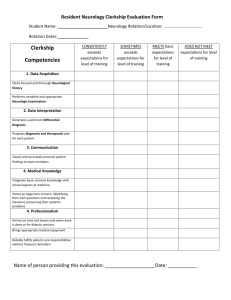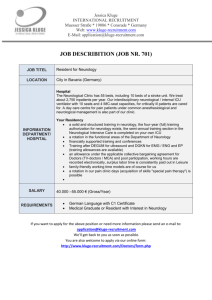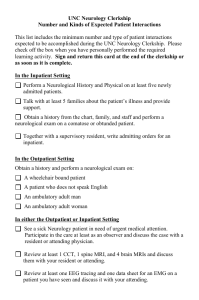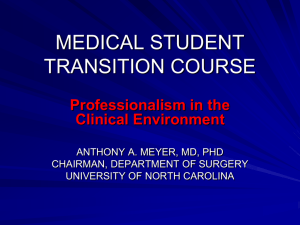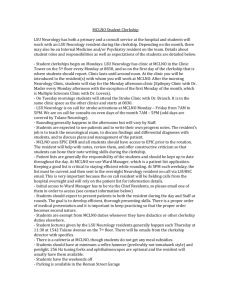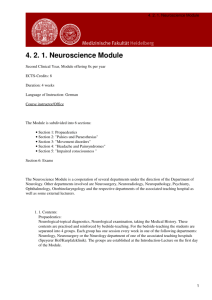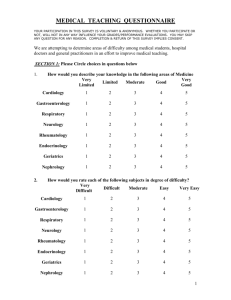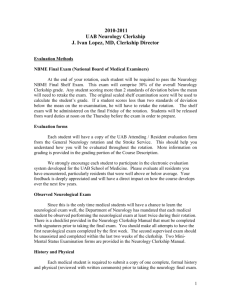Clinical Neurosciences Clerkship
advertisement
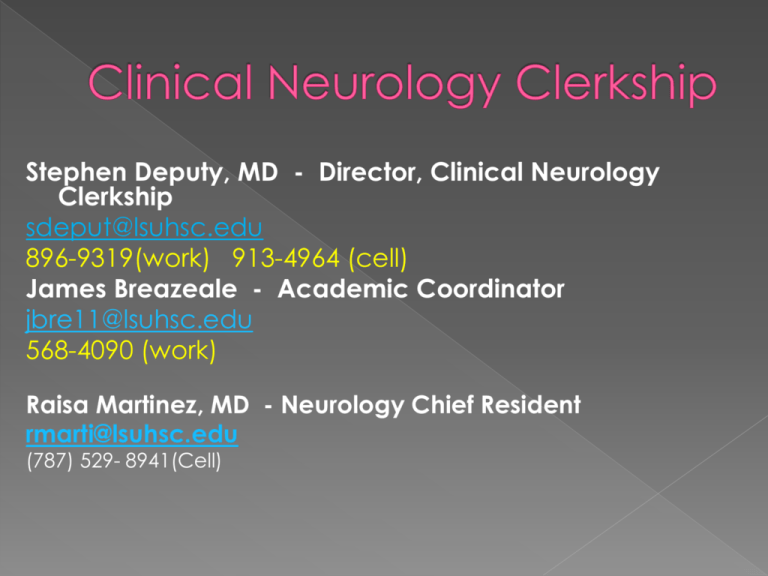
Stephen Deputy, MD - Director, Clinical Neurology Clerkship sdeput@lsuhsc.edu 896-9319(work) 913-4964 (cell) James Breazeale - Academic Coordinator jbre11@lsuhsc.edu 568-4090 (work) Raisa Martinez, MD - Neurology Chief Resident rmarti@lsuhsc.edu (787) 529- 8941(Cell) Rotation Sites St Charles Hospital LSU Faculty Clinics Participate in clinics run by LSU Faculty at the St Charles Hospital site Monday-Thursday Try to identify one attending physician that you worked with the most from each week to evaluate your clinical performance Rotation Sites LSU Interim Hospital Round on Inpatients at the Interim Hospital on all days Clinics at Lord and Taylor › › › Monday AM: Neurology Resident Continuity Clinic Monday PM: Either MS Clinic or Epilepsy Clinic Tuesday: Stroke Clinic Do not forget to be prepared to present a patient for Professor’s Rounds on the second Thursday Rotation Sites Touro Hospital Manage inpatient consults at the Touro Hospital Campus Students need to fill out paperwork (which will be emailed to you) and present it to the medical staff office on the first day to receive a temporary ID and parking Rotation Sites Children’s Hospital Round on inpatients with child neurology attending, child neurology fellow, and adult neurology residents Spend one week doing outpatient child neurology in the clinics Fill out paperwork (that will be emailed to you) to be able to log on to the Sorian computer system Questions on where you are going to be or who you will need to contact? Duties of Students Equipment Each student should own or have access to the following equipment in order to adequately exam patients with neurological disorders: • • • • • • Ophthalmoscope (Welsch Allyn or Pan-Optic head) Snellen Eye Chart Reflex Hammer (preferably Queen Square type and not Tomahawk type) Flashlight (or penlight) Tuning Fork (C-128 for vibration sense detection +/- C-256 or 512 for hearing) Your Brain!!!! Duties of Students Didactic Lectures Neurology Resident Clinical Cases (weeks 1-3) How to Perform the Neurological Examination (week 1) Applicable Neuroradiology (week 2) Student Professor’s Rounds (week 2) Neurology Review (week 3) Lectures are held on Thursday afternoons (see calendar) in room 111 of the 1542 Tulane Ave Building. They are mandatory for all students. Those rotating in Baton Rouge will be able to participate with didactic lectures via teleconferencing. Didactic Lectures Neurology Resident Clinical Cases 3 separate groups of cases to work through with students Cases are symptom-based After History and Exam are given, students should: Localize the site of the neurological deficit(s) Come up with a differential diagnosis Order appropriate diagnostic studies Diseases are briefly discussed with a “Pearls and Pitfalls” section Didactic Lectures How to Perform a Neurological Examination The 6 subsets of the neurological examination are elucidated Concept of a “screening neurological examination” introduced Each subset of the exam is reviewed anatomically and techniques for evaluation are discussed Afferent and Efferent pathways for reflexes are presented Bring your Passport to take notes Didactic Lectures Applicable Neuroradiology Lecture Reviews various types of Neuroimaging Modalities Reviews Neuroanatomy from a Neuroradiology perspective Reviews the Neuroradiographic findings of some common pathologic processes Student professor’s Rounds Students assigned to University Hospital are responsible for bringing a case to the conference Only one student needs to present the case Be sure to include pertinent details from the Chief Complaint, HPI, PMHx, PSHx, Social Hx, Medications and their Dosages Present the Physical Examination and a DETAILED Neurological Examination The other students should be prepared to discuss a pertinent Differential Diagnosis based on Localization of the disease process and request specific diagnostic studies Discuss the results of Diagnostic Studies Discuss Treatment and Outcome of the patient Neurology Review Lecture Briefly touches on important clinical aspects of multiple Neurological Disorders to help as a study guide for the SHELF Exam Topics include: CNS Infections, Auto-immune disorders, Epilepsy and Sleep disorders, Vascular disorders, Headache and Pain syndromes, Trauma, Degenerative disorders, Altered Mental Status, Movement disorders, Structural abnormalities, Toxic and Metabolic disorders, Psychiatric conditions, Neuromuscular disorders, Anatomy and Localization. Progress Notes Progress notes should be written as frequently as the patient’s condition warrants. These can be written on hospital Progress Notes sheets but should be identified as L3 with signature and should be cosigned by staff or resident. Students working at sites with EMR will need to follow each system’s protocal. Each medical student is expected to be an active participant of the team to which he/she is assigned. Responsibilities include, but are not limited to, participating in all work rounds (except when didactic lectures are occurring), reviewing all pertinent laboratory studies obtained on his/her assigned patient (including blood work, CSF results, neuroimaging results, and electrodiagnostic studies), and writing daily progress notes on the patients that they are assigned to follow. The official Student Leave Policy During the Neurology Clerkship essentially states that students should try and minimize absences during required clerkships. During this short 3 week rotation, you will be allowed no more than 2 days for an excused personal absence. It is preferrable that you do not miss the Thursday didactics if at all possible, as you will be assigned additional make-up assignments. It is expected that you inform your resident as well as other students on the team of any planned absence so that your patient care duties can be covered. You must also inform the clerkship administrative assistant (JB) as well as the Clerkship Director in writing (by email) of your planned absences at or before the beginning of the 3 week sub-block and receive permission to take said absence, otherwise it will be considered unexcused. Unexcused absences may be grounds for failing or repeating the clerkship. Work Hours In recognizing the time commitment required of medical students during clinical rotations and taking into account the effects of fatigue and sleep deprivation on learning, clinical responsibilities, and student health and safety, the following duty hour limitations have been adopted by the LSU Clerkship Directors as of 5/22/08 and are to be followed without exception: 1. Duty hours must be limited to 80 hours per week averaged over a fourweek period, inclusive of all clinical and didactic learning activities. 2. Students who are assigned to overnight call in the hospital should not have patient care responsibilities after 1:00 PM on the following day. 3. Students will be expected to attend mandatory didactic activities even after overnight call. Any breech of the outlined work hour limits described above should be reported directly to the Director of the Clinical Sciences Curriculum, the Associate Dean for Student Affairs, the Assistant Dean for Student Affairs, or the Assistant Dean for Undergraduate Medical Education. On Call In-house call is not required during your Neurology Clerkship (However, if you have a particularly good resident and wish to take call electively to gain further clinical experience, please feel free to do so) Junior Neurology Clerkship Passport Neurology Passport The Junior Neurology Clerkship Passport is a companion guide to help you get through your Neurology Clerkship. It contains: Important neurology resident and attending contact information and rotation schedules. Information on how complete and submit for credit: › Neurological Examination Basic Competency › Neurological History Basic Competency › Written Note Evaluation › Patient Log › Student Presentation(s) Neurology Passport The Neurology Passport also includes useful references The Neurological Examination document Anatomical charts for nerves and muscles innervated by the brachial plexus and L/S plexus Anatomical chart for sensory dermatomes Differential Diagnosis by disease category Developmental Milestones A separate handout will contain the NIH Stroke Scale Basic Competencies: Neurological Examination Skills One of your learning goals during the clerkship is to improve your competency in performing a neurological examination. During your Neurology Clerkship you will be asked to formally demonstrate your neurological examination skills on at least one of the patients that you are taking care of (though the more you do, the better you will get with these skills). Have an attending physician or neurology resident (PGY-2 or above) sign off on the Basic Competencies Document located under the “evaluations” section contained within with in your New Innovations page. Basic Competencies Adult Neurology: Neurological Examination Skills. Minimum Criteria The Neurological Examination demonstrates completeness by: Containing components from each of the six sub-sets of the neuro exam (mental status, cranial nerves, motor, sensory, coordination and gait) Application of the Neurological Examination by: Correctly interpreting normal and abnormal findings to aid in localization of the disease process. Use of the neurological examination to quantify the severity of any neurological deficits identified. Professionalism: The approach to the patient during the examination shows respect for the patient’s privacy and dignity. Basic Competencies Child Neurology: Neurological Examination Skills. Minimum Criteria The Neurological Examination demonstrates completeness by: Containing components from each of the six sub-sets of the neuro exam (mental status, cranial nerves, motor, sensory, coordination and gait), even if just by observation. Pertinent “non-neurological” aspects of the examination are demonstrated (head circumference, dysmorphic features, cutaneous findings, etc). Application of the Neurological Examination by: Correctly interpreting normal and abnormal findings in an age-specific fashion Use of the neurological examination to aid in localization of the disease process Professionalism: The approach to the patient shows courtesy and respect for the child’s modesty and parental concerns Basic Competencies: Taking a Pertinent Neurological History Your neurological history should include information concerning the onset and evolution of any neurological complaints as well as their chronicity. The history should also allow for some degree of localization of the disease process. Be sure to include how the deficits functionally impair the patient Have an attending physician or neurology resident (PGY-2 or above) sign off on the Basic Competencies Document located under the “evaluations” section contained within with in your New Innovations page. Basic Competencies Adult Neurology: Pertinent History Taking Skills. Minimum Criteria The history contains enough information to begin the process of localization The history contains enough information to gain an understanding of the chronology and severity of the disease process Information is obtained concerning psychosocial functioning of the patient as it pertains to his/her illness Medication dosages and allergies are accurately listed Basic Competencies Child Neurology: Pertinent History Taking Skills. Minimum Criteria The history contains enough information to begin the process of localization The history contains enough information to gain an understanding of the chronology and severity of the disease process A thorough developmental history/school performance history is identified Medication dosages and allergies are accurately listed Student Presentations Students are required to prepare and present at least one brief presentation concerning some aspect of the disease that their patient has (diagnosis, treatment, prognosis, etc.) This demonstrates independent learning which is strongly encouraged during the clerkship Each time that you give a presentation to your team, please document the date and topic of your talk on your New Innovations page. Click on the attending or resident who you presented to in order to receive credit for giving your presentation. Student Presentations Clerkship Expectation Attending Evaluation of Written Notes It has come to the attention of the clerkship directors that students may not always be receiving appropriate feedback about their written notes from their attending staff physician(s). As such, during each clerkship, students will be asked to have at least one written note critically evaluated by their attending physician. For the Neurology Clerkship, I am asking that this helpful exercise be completed on two occasions. After the attending physician has critically reviewed your written note and provided direct feedback to you, please send them a New Innovations invitation to sign off on your written note skills. Student Presentations Put New Innovations image here Patient Log The Liaison Committee on medical Education requires that each clerkship specify the number and kinds of patients that students must evaluate in order to achieve the objectives of the clerkship. The Neurology Clerkship Grading Committee has determined that each student must be involved in the care of at least two patients with the following conditions: Paroxysmal Disorders Vascular Disorders Neuromuscular Disorders Progressive Degenerative Disorders You are required to document your Patient Log on your New Innovations page as a requirement of this clerkship. You do not need to have your patient log signed off by an attending or resident and your grade will not be influenced by the numbers of patients you have seen. Patient Log Disease Examples Paroxysmal Disorders Adult Neurology examples include: Headaches, Seizures, Epilepsy, Channelopathies, etc. Child Neurology examples include: Headaches, Seizures, Epilepsy, Myotonia or other Channelopathies, etc. Vascular Disorders Adult Neurology examples include: Stroke, Intracranial Hemorrhage, Hypertensive Encephalopathy, Hypoxic-Ischemic Encephalopathy. Child Neurology examples include: Childhood Stroke, Neonatal Intraventricular Hemorrhage or Periventricular Leukomalacia, HypoxicIschemic Encephalopathy. Patient Log Disease Examples Neuromuscular Disorders Adult Neurology examples include: Myopathies, Guillan-Barre Syndrome, CIDP, Charcot-Marie-Tooth, Diabetic Neuropathy, Amyotrophic Lateral Sclerosis, Traumatic or Focal Neuropathies, etc Child Neurology examples include: Congenital Myopathies, Muscular Dystrophy, Guillan-Barre Syndrome, Spinal Muscular Atrophy, Charcot-Marie-Tooth Disease Myasthenia Gravis, Erb’s Palsy, etc. Progressive Degenerative Disorders Adult Neurology examples include: Alzheimer’s Disease and other Dementia’s, Huntington’s Disease, Parkinson’s Disease, Vascular Dementia, etc. Child Neurology examples include: Leukodystrophies, Neurodegenerative Disorders, Metabolic Disorders, Brain Tumors, etc. Neurology Clerkship Clinical Evaluation Clerkship Competencies (6 Domains) Medical Knowledge Patient Care Interpersonal Relationships and Communication Practice-Based Learning and Improvement Systems based Practice Professional Behavior Neurology Clerkship Clinical Evaluation Always Exceeds Expectations for level of training* Sometimes Exceeds Expectations for level of training* Meets Expectations for level of training* Does Not Meet Expectations for training* *Guidelines for the various expectations for each item graded are available on the Student Web Page in a document entitled “The Neurology Clerkship Clinical Evaluation” as well as on your New Innovations page under “More” then “Resources” Neurology Clerkship Evaluation Form Does Not Meet Expectations for level of training A grade of “Does Not Meet Expectations” for Competency Domains 1-5 should prompt a meeting of the student with the Clerkship Director to develop a plan for remediation and may be grounds for failure of the clerkship. The evaluating faculty member should contact the clerkship director for clarification. Medical Knowledge 1. Demonstrates adequate understanding of the pathology, pathophysiology, and anatomic features of neurological diseases. 2. Participates regularly in activities that advance knowledge and competence Patient Care 1. Takes a pertinent and thorough Neurological History containing information which provides some degree of neurological localization and allows for an understanding of the chronology and severity of the disease process. 2. The history contains accurate medication dosages, formulations and drug allergies 3. Is able to demonstrate a thorough Neurological Examination that contains pertinent aspects from each of the 6 realms of the neurological exam and contains enough detail to localize the disease process. 4. Generates a pertinent Differential Diagnosis that takes into account disease localization and prioritizes the most likely diagnosis Patient Care (cont’d) 5. Develops an appropriate Diagnostic Plan specific to the unique aspects and needs of their patients 6. Develops an appropriate Treatment Plan specific to their patient’s illness 7. Provides effective care with respect to the patient’s psychosocial level of functioning and their cultural beliefs Interpersonal Relationships and Communication 1. Clearly and accurately presents patients findings to team members 2. Maintains clear, complete, accurate, timely and legible medical records 3. Shows empathy and respect to patients and their families Practice Based Learning and Improvement 1. Uses evidence from practice guidelines and scientific studies to develop appropriate diagnostic and treatment plans 2. Shows an eagerness to learn, identifying their own questions and reviewing the literature concerning their patients’ illness Professional Behavior Maintains honesty and integrity in written documentation Establishes professional relationships with patients and families Reliably fulfills patient care responsibilities without frequent reminders Functions as a respectful and helpful team member Arrives on time and leaves only when work is done or for didactic sessions Seeks feedback and/or responds well to constructive criticism in order to improve performance Professional Behavior A grade of “Does Not Meet Expectations” for Professional Behavior items shall prompt a Physician Evaluation Form, which will be completed by the Clerkship Director and discussed with the student. The evaluating faculty member must contact the Clerkship Director for clarification. Unprofessional behavior may also be grounds for failure of the clerkship. Each student’s Clinical Grade will be based on the following format: The mean clinical grade scores and standard deviations for each evaluating attending physician are determined and continually updated. The student’s numerical score is derived from their Clinical Evaluation and is then compared to that of the attending physician. Honors: Score is greater than +0.50 SD’s above the mean for the attending physician High Pass: Score is between (and includes) -0.50 SD’s below the mean and +0.50 SD above the mean for the attending physician Pass: Score is between -2 SD’s below the mean and less than -0.50 SD’s below the mean for the attending physician Fail: Score is below -2 SD’s below the mean for the attending physician* *Students may also be in jeopardy of failing the course for behavior deemed to be unprofessional. The Written Examination › Beginning with the 2009 Academic Year, the Clinical Neurosciences Clerkship started to use the USMLE SHELF examination as it’s instrument to assess student’s clinical knowledge. This test has been extended to the Junior Neurology Clerkship as well. The test is highly geared towards adult neurology (though there are some child neurology questions as well). In order to prepare for this examination, it is strongly encouraged that each student review the supplied curriculum of reading materials contained within the LSU Neurology department website www.medschool.lsuhsc.edu/neurology More to Come Other Resources to Aid in Preparation for the SHELF Examination Resources Contained on the Neurology Web Page and your New Innovations page Neurology Case Files (Lange Case Files) Blueprints Neurology (Blueprints Series) USMLE World Step 2 CK (Neurology Questions) Neurology Pre Test Self-Assessment and Review The Neurology Chapter contained within your Internal medicine Textbook The Written Examination Students are required to obtain a score of at least 59 on the SHELF examination in order to pass the clerkship. Those students who score less than 59 will need to either repeat the SHELF examination at the end of their Junior year and score a passing grade in order to receive a Pass final grade for the clerkship. SHELF scores will be weighted compared to other students nationwide doing a 3 week Neurology Clerkship. The Written Examination Passing SHELF scores will be translated into a Written Examination Grade for the Neurology Clerkship This process involves taking last year’s national USMLE mean scores for three week long Neurology Clerkships (For example, during the 2012-2013 year, the national mean was 76.3 with a standard deviation of 8.2) For the LSU Neurology Clerkship, this would translate into Clerkship Written Exam Grades of Honors: Score is greater than +0.5 SD above the mean (>80) High Pass: Score is between (and includes -0.5 SD below the mean and +0.5 SD above the mean (72-80) Pass: Score is between (and includes) 59 and below -0.5 SD below the mean (59-71) Fail: Less than 59 Final Clerkship Grade Schemata Each student will receive a Final Assigned Grade for their Neurology Clerkship based on a combination of their Clinical Grade and their Written Examination Grade as follows: Honors: Will need to have a combined averaged Clinical and SHELF Standard Deviation Score > +0.5 High Pass: Will need to have a combined averaged Clinical and SHELF Standard Deviation Score between and including -0.5 and +0.5. Pass: Will have a combined averaged Standard Deviation Score between -2 and <-0.5. Fail: The averaged SDS score is < -2, the Clinical Grade is a Fail or the student is unable to score a passing grade on the SHELF examination despite repeated attempts (LSU School of Medicine Policy). Also, a Fail grade is possible if the student engages in unprofessional behavior that cannot be rectified per the Clerkship Director’s discretion. Final Clerkship Grade Schemata Each student will receive a Final Assigned Grade for their Neurology Clerkship based on a combination of their Clinical Grade and their Written Examination Grade as follows: Baton Rouge Branch Campus Students will receive a clinical grade of either Honors, High Pass, Pass, or Fail based on input from Dr. Karam and Dr. Barkemeyer. They will also receive a numerical grade through New Innovations. Their weighted SHELF score will be factored into a similar Honors, High Pass, Pass, or Fail based on SHELF means and SD’s. Final grade will be the lowest of the Clinical and Written grades with an Honors and Pass split being assigned a High Pass. Student Feedback about the Junior Neurology Clerkship Through the Aesculapian Evaluation Through a Neurology requested New Innovations Evaluation Student Feedback about the Junior Neurology Clerkship Note: Your feedback is extremely important and will allow us to continually update and adjust different aspects of the Clinical Neurosciences Clerkship. Following the completion of the SHELF examination, each student will receive notification from New Innovations and asked to complete the Neurology Clerkship Student Feedback. Answers are stored and returned to the clerkship coordinator anonymously. Negative feedback will in no way influence your final grade. Please feel free to directly email the Clerkship Director (Dr Deputy) at sdeput@lsuhsc.edu if you have any further suggestions or comments about your experiences during the rotation. Questions??? Now go out there with an open mind and discover the amazing complexities of the science and art of Clinical Neurology
